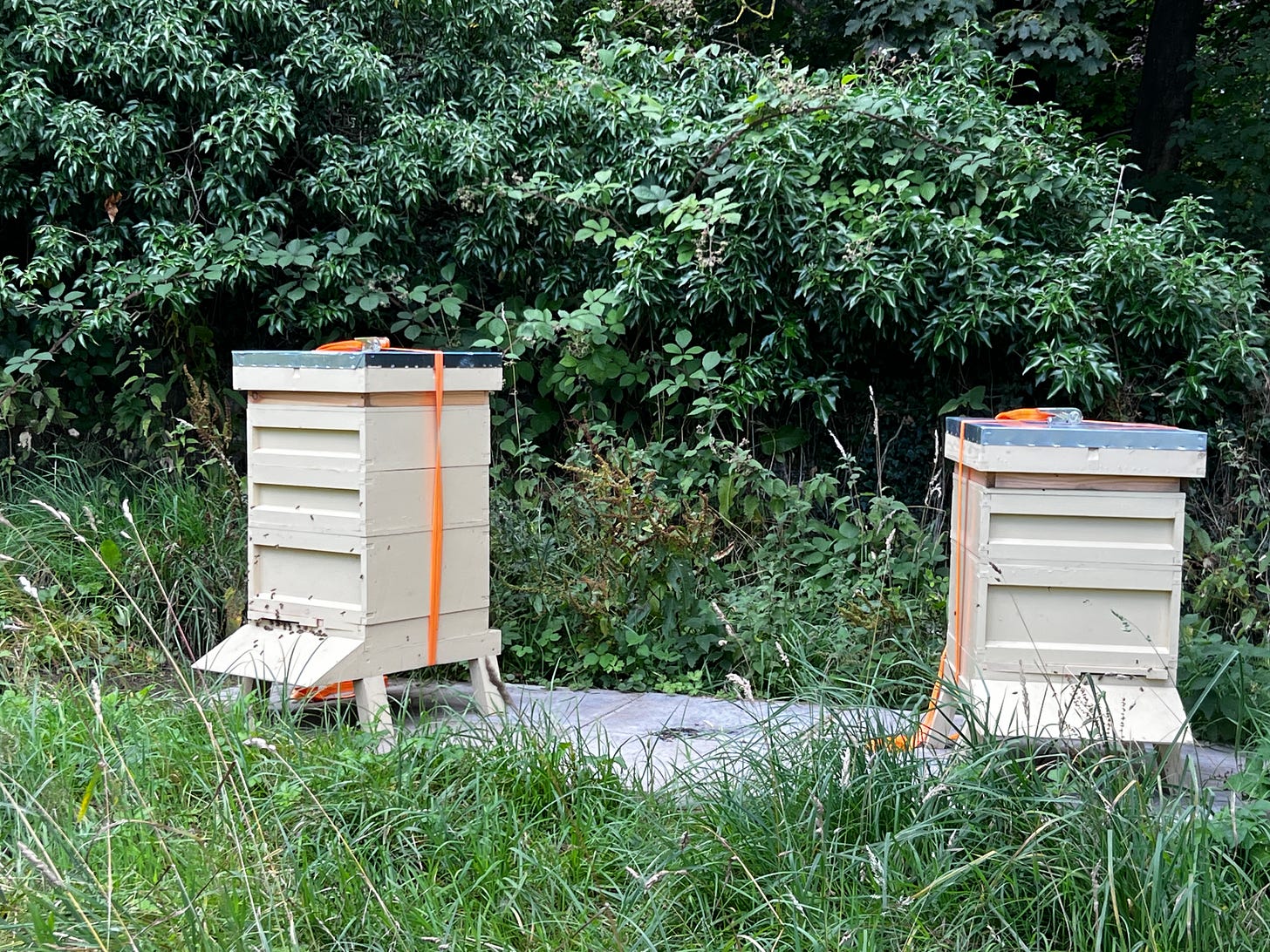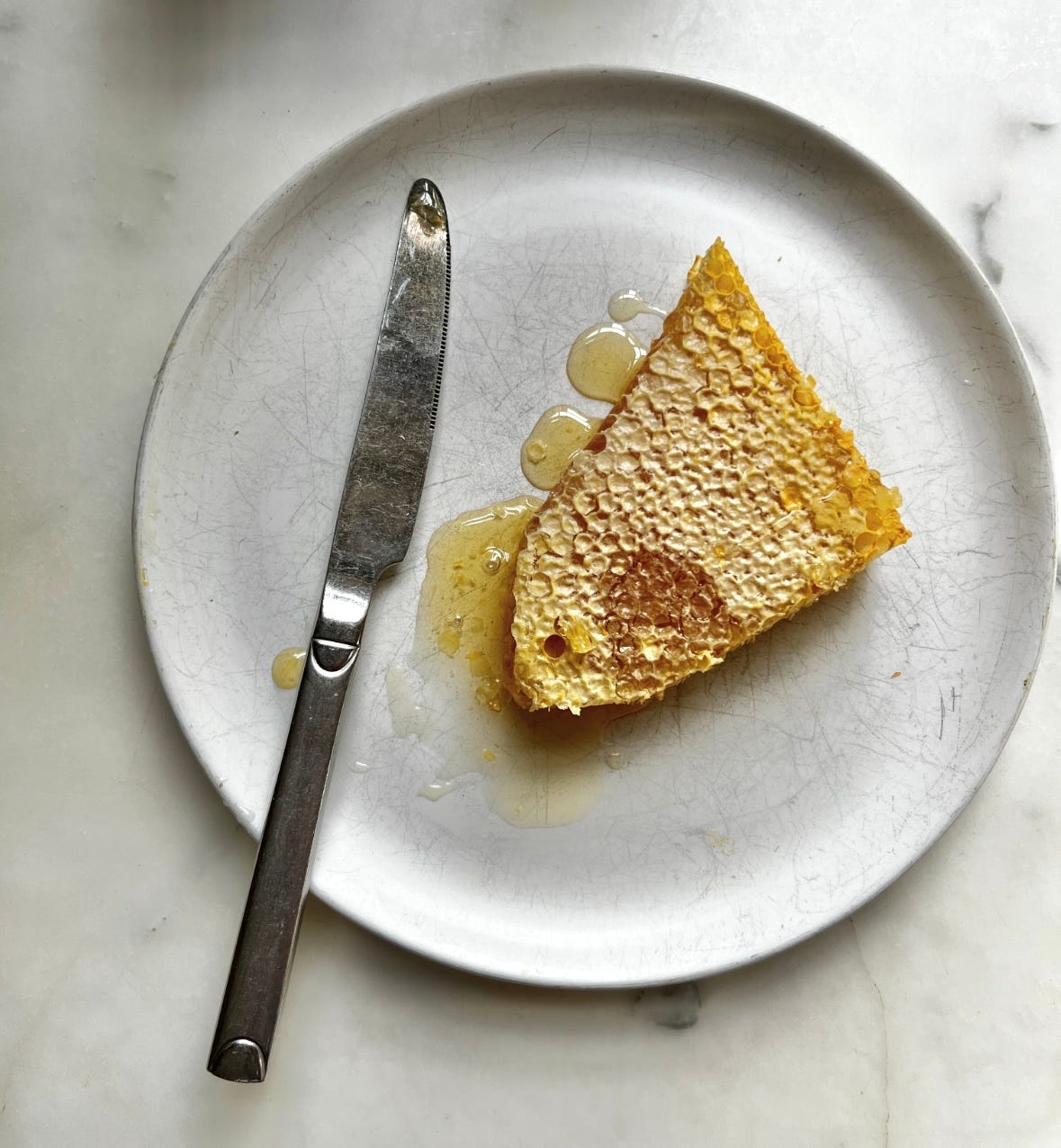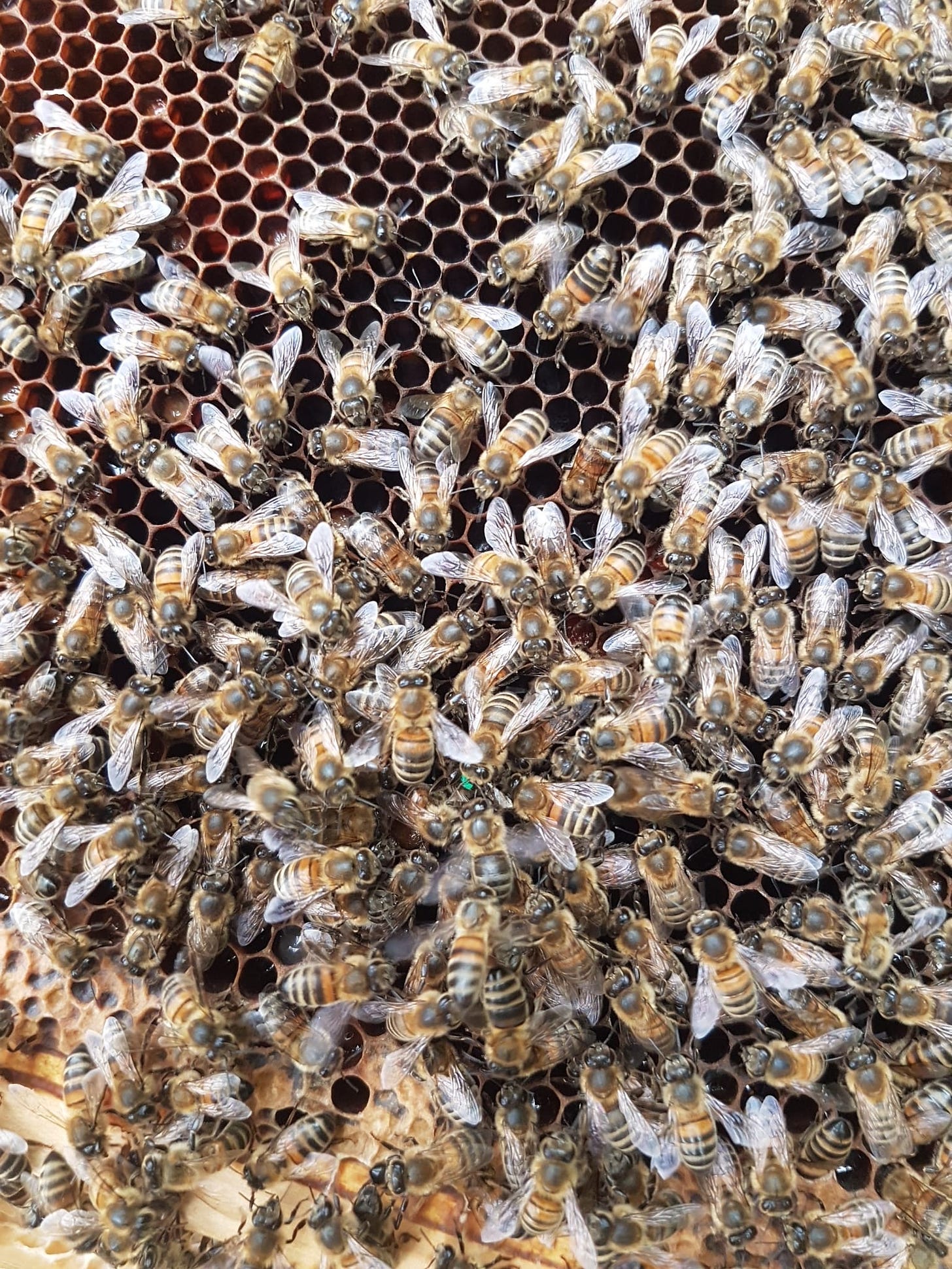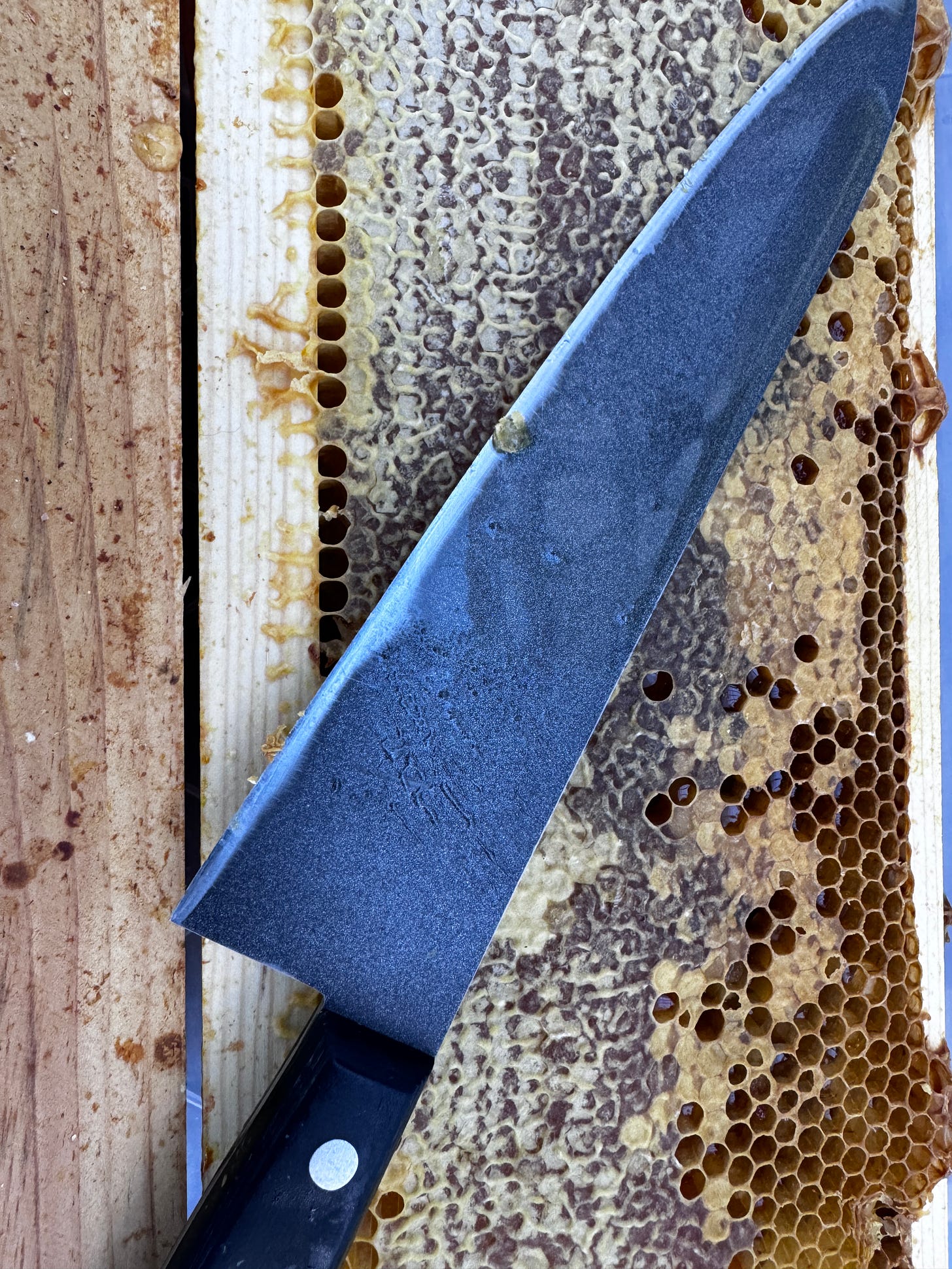West Berkshire, October 2024
I find that many of you here are new readers.
Welcome to my essays.
Here’s a little context on today’s piece.
On the little farm tucked away in rural England, where I work as a Private Chef, we have two beehives that I am the guardian of.
For the last two years, I have often shared here in these words, some of the ups and downs of looking after these two colonies of curious little insects. Quiet little creatures, fuzzy, kind and intelligent, insects that buzz softly and walk lazily over your gloves as you handle them, as I work through their wooden frames capped with wax, filled with life, ensuring that they are well, their home is safe and they are well fed. They have been gentle, inquisitive and more than happy to be looked after by humans since their arrival here.
This has changed somewhat since summer.
I still look after the two colonies, they still sit in the orchard as they always have so no change there.
What has happened however is that they have turned feral.
Completely predatory.
Something akin to shaking your hands in a box full of broken glass and throwing a few handfuls in the air for good measure (all be it with four litres of pure wildflower honey to show for my troubles at the end of the summer) is where we are at the moment.
What I have here, is quite simply two wooden boxes full of thousands upon thousands of tiny psychopaths
Almost like the unfriendliest pub that you’ve ever visited
They give me no favour at all, nor seem to let up in their pursuit of me.
After the last trip that I wrote of earlier this month, when a visit to gauge how the bees were faring before the onset of the cold months, ended up with me relentlessly pursued around the apiary by hundreds of spicy bees, a handful invading through a small hole in my suit, leaving me having lost count of the number of stings administered. Housekeeping necessitated that I needed to visit them again.
When looking after bees, there are specific tasks that need to be carried out at certain points in the year and with the arrival of autumn, comes the need to protect the colony from the colder months that lay ahead, to check that they have hidden away plenty of food in the waxy, wooden frames, sealed neatly into hexagonal cells. I must ensure that errant wildlife can’t topple them over and that mice can’t break in to overwinter with them in the warmth of a sealed wooden box. ( I must say that I think it would have to be a very silly family of mice that might consider this).
I successfully managed to remove our share of the honey frames last week. (let it be known that we only take a small portion of what the bees produce, the rest is left for them, as it is their food for winter) By placing a clearing board between the wooden box where the honey frames are stored and the brood box below, enabling the girls to descend to the pheromone of the queen, without causing too much trouble to anyone, thereby leaving the sealed, wax-capped combs of honey free from anything that might want to sting me later. The bees were mainly cooperative at this point, letting me manipulate them and insert the board, and as neither Molly nor myself were attacked, I remained hopeful that the next visit might go smoothly.
Waiting a day for the bees to clear downwards to the warmth and security of the hive, leaving the box of honey frames clear of bees, (at least this is how it should go), then swiftly lifting the heavy box full of honey up and away, closing them up quickly and walking swiftly away to store it for a few days wrapped in bubble wrap. Two visits in as many days with only a handful of warning shots fired at me, though I haven’t opened them up, seems a little encouraging.
I have spun out over four litres of fragrant wildflower honey for the kitchen in the year ahead in our new electric spinner. It is thick, pale and clear, slightly lemony if I concentrate on what I’m tasting, perhaps down to the lemon trees that flower through the year that stand on the stone terraces here at the back of the house.
The hives are now ready for me to prepare them for winter.
This next visit wouldn’t be a short check-through, and with now both hives needing insulating, feeding and some changes to the set-up (involving hefting off the different parts, moving them around and putting them back together again). It will be an hour or so of work.
I must admit to not so much being nervous to open the hives, but being completely terrified and once again the bees certainly didn’t let me down.
Deep breath.
Armour
I’d bought myself a stout pair of goatskin gauntlet gloves for the occasion. Old-fashioned beekeeping gloves from another era that aren’t particularly useful for the fiddly work of handling bees and their frames, surgical gloves are much more efficient as you can feel what you pick up. You can feel them fizzing over your hands as they move quietly about their business. These new leather gloves are about three millimetres thick and the length of the sting of a bee is a little over one and a half millimetres so in theory they are stingproof. You can’t really feel anything so they are clumsier, and that might cause you to squash one or two without realising.
As I’m now pretty much scared witless of our bees, not bees in general at all to be clear, just ours, I (wrongly) assumed that with leather gauntlet gloves I couldn’t get stung. These small bees are so clever as to be able to distinguish the location of the seam in a glove, where the leather meets the cotton at the wrist.
Today I needed to add thick foam insulating panels to the inside of the roofs to prevent condensation from forming as the weather gets cold. Condensation drips onto the cluster and is a terrible thing to happen to them so must be prevented.
My smoker is full of wood chippings, broken bits of pine cones and damp leaves to cool the smoke. It is lit and closed shut, its gentle story of grey smoky tendrils rising from the vent. I puffed a little around the entrance to send any guards back inside and after waiting for a few minutes, I popped open the clasp and removed the ratchet strap that keeps everything in the hive tightly pressed together, in case curious deer or badgers come scratching their backs and potentially sending the towers tumbling over.
So before even really starting this visit I’ve two stings to the wrist in the first couple of minutes just by taking the roof off, forcing me to retreat to safety, my veil thick with angry workers, and this is from what is usually the most temperate of our hives.
I waited for ten minutes, hiding actually, half in a hedge until it was safe to deglove and administer an anti-histamine cream, then put on two pairs of marigolds (bright yellow, rubber washing-up gloves) and topped them off with my new leather gloves. It has been said to me that leather gloves are for hedge laying rather than working with tiny insects, but I say whatever.
Please feel free to come and work through these hives with a single pair of vinyl gloves to prove a point if you must.
Hive One
With the roof taken off from the first hive, a handful flew up to let me know that they weren’t overly impressed and for my endeavours, they stung me twice.
I measured the slab of foam, quickly cutting it with a saw whilst under attack, and then, away from the hives hurriedly pushed it to fit inside the thick square cedar roof panel. I lifted the crown board that covers the inside of the hive, so the frames were now open, and was greeted by the welcome party, buzzing at my veil trying to sting my face. I pushed two strips of a varroa mite treatment down into the dark gaps (Apivar for those who might be interested) which I must remove in mid-December (great… I’m looking forward to that), then changed the crown boards from the old solid wooden version to perspex frames that will enable me to be able to admire the contained malevolence from above in winter without taking off the lid.
With my wrist throbbing and my anxiety rising, wondering how it might feel if my tongue suddenly started to swell in my mouth, if on a whim my body decided to throw me a curveball and have an anaphylactic reaction. I shut the first hive up quickly, tensioning the ratchet handle, the mechanism clicking loudly as it tightens the boxes into a solid stack whilst being swirled by hundreds of angry girls. I took a wander to the far side of the orchard to contemplate what lay ahead in the next hive, a far stronger colony that is extremely aggressive, accompanied by what must have been the core of the most annoyed of the bees in hot pursuit, spurred on in their fury by the bouncing Lurcher that belongs to John, an enthusiastic young dog who at that moment decided that I must have looked interesting from a distance, with my flapping around like a fool in the woods, and who came running towards me with her ball in her mouth ready for me to throw.
Hive two
Summoning my courage, the second hive needed to be opened.
I’m not normally one to shy away from a problem, and nor was I about to, but I’ll be honest, I would probably rather have poked myself in the eye with a stick at this point than go and open the other hive.
I wasn’t to be disappointed.
As soon as the ratchet popped open with its unnervingly loud crack that echoed throughout the wooden structure, alerting the tens of thousands of stinging residents that all might not be well, as a clumsy, large creature was about to ruin their dark, quiet and warm home by exposing them to a cloudy damp afternoon and start moving their possessions around. They plumed out the entrance block straight onto my ankles.
Not even a buzz to the ear as a warning.
Taking a deep breath, I held my nerve and prayed that I’d closed my suit properly, unlike my previous visit when it became apparant that the slightest tiny hole is enough to allow angry bees enough space to climb inside and wander around my face.
Working methodically away from the open hive, accompanied by hundreds of angry residents, I fixed their insulation, repaired a broken frame, inserted varroa treatment and replaced the wooden crown boards with perspex as I had in the other hive. I had to walk away, deep into the trees several times to try to discourage them from their relentless quest to punish my impudence, my veil a mass of high-pitched frenetic fury and I was stung in the neck by a bee that was intent on pushing the mesh of my veil up against my face (they know exactly what they are doing) and as I was unable to remove the sting quickly, was administered with the full dose of venom and have subsequently been walking around with a bright red, swollen welt on my neck for the last three days.
It took me three attempts to close them up in their hive, to collect my tools and load the wheelbarrow, my suit and gloves, rich with attack pheromone so any chance of this being easy at this point had long since left the occasion. I left the spare parts of the hive that I had changed and leaned up against the entrance ramps as they were still clustered with bees and they needed time to be persuaded to walk back inside.
They can stay there for a while.
Ankle biters
On the walk back to the house, and once the sentries had decided that I was no longer a threat to them, I picked out no less than ten stingers from the fingers of the leather gloves, glad that I hadn’t heeded the advice to wear my disposable ones.
As it stands, as I no longer have a bee mentor, so am now relying on the wisdom I find via an online forum from those that know, and it seems that I’m the butt of the other beekeeper’s jokes. ‘Nothing unusual’ they say, ‘Ankle biters’, ‘Baptism of fire’, ‘Oh well’ etc. It is something that must be dealt with in good humour it seems.
Understanding the change in temperament is something I am trying to find an answer to and it may be that it is likely a third-generation-queen genetic trait, which is not uncommon. This being said bees are creatures governed by the seasons, so their preparations for winter are well underway, and they may be annoyed at the temerity of anyone who wants to disturb their peace. There could be animals at night interfering with the hives that worry them, or it could just simply be a case of a good old-fashioned bad temper. Luckily they have the winter to reset themselves, though it is said that this is unlikely, but I must give them a chance. I must open them again in mid-December to remove the varroa mite treatment that I have added, and as the colony will be clustered for winter, they will likely present less of a threat. They will then remain closed until early April, so perhaps they might have worked through their anger by then.
Perhaps.
Spring will be key.
And if they are still as angry next year, after winter has passed, then I will need to re-queen them early in spring, a feat that fills me with trepidation.
Onwards.
Until next time
William
The two recipes I promised you last time are in my draft file as I write this, and they will be with you midweek.








Oh my gosh. I'm concerned for you, but I'm also giggling at the same time. Sorry. I wish you well and for a speedy recovery. I think Steve Martin should play you if your stories ever end up becoming a movie. Best of luck, Chef!
Bees (like horses) respond to the smell of fear in the air. If you ride a horse with trepidation in your heart it will very likely do its best to unseat while it is nervously looking around for whatever it is that it smells you are afraid of. I wonder if this is what is going on with your bees. Maybe taking a valium to calm you (or drinking a bucket of valerian tea) in advance of the next visit might help (not trying to be facetious!). Good luck.